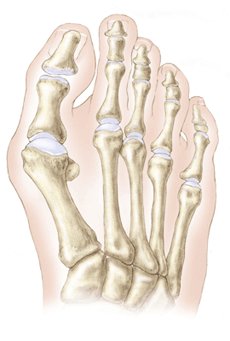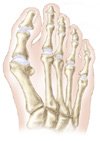A bunion (hallux valgus deformity) is a bony bump on the outside and top of the great toe, where it connects to the foot. Half of those who have the problem will have bunions on both feet. Only a small number of people develop a bunion in childhood, and there is some evidence that, in these cases, heredity may play a role. Women develop bunions ten times more often than men, and they are usually in their 40s or 50s when the deformity becomes a problem. This may be because, over the years, they have worn shoes that are too narrow, causing pressure on the great toe. Over time, the pressure from shoes with pointed toes and high heels can deform the great toe, and encourages the bony growth that eventually becomes a bunion.
The function of the great toe is very important to normal gait. The great toe is stabilized on both sides by ligaments, and when a step is taken, the stability of the arch is maintained through the great toe's movement. When the foot moves through a step, the great toe extends, causing the arch to rise, and stabilizing the arch at the same time. This is called the windlass mechanism. Patients with moderate to severe bunion deformities may have an abnormal gait because the bunion has compromised this mechanism.
There are all types of bunion deformities, ranging from mild to quite severe. Larger bunions are generally more painful. Some people can develop pain in the second toe as well, due to instability caused by pressure from the deformed great toe.
Overview

What are the signs and symptoms of hallux valgus?
The main symptom is pain in the bunion area itself, which is caused by long-standing pressure from a shoe or boot. There can also be pain associated with a nerve that passes over the top of the bunion, especially when this nerve is irritated by shoe pressure.

How is a bunion diagnosed?
When the patient stands with the weight evenly distributed, the bunion is evident as a bony growth protruding from the metatarsal head at the base of the great toe, which is angled in toward the other toes. Sometimes the pressure against the second toe causes it to deform into a "hammer toe" . This condition may be more painful than the bunion itself, and can occasionally cause the second toe to partially dislocate. This can lead to the formation of a callus (transfer lesion) under the metatarsal head, which can be very painful. X-rays can reveal the extent to which the second toe is dislocated.
How is a bunion treated?
Non-Operative Treatment
As a general rule, a bunion does not require any treatment other than a soft shoe with plenty of room for the front of the foot.
A wide toe box will provide protection for the affected area.
Shoes that have a seam or lace that crosses the bunion area should not be worn.
A soft arch support or a sling may take pressure off the second toe.
Operative Treatment
Surgery may be necessary if the patient has a severe deformity that causes constant pain, a dislocation of the second metatarsophalangeal joint (at the base of the great toe), or hammer toes. Bunion surgery should be chosen only when conservative treatment has failed. It should never be performed for cosmetic reasons.
There are many surgical procedures for the treatment of bunions. The severity of the condition will determine which operation is chosen. The surgery is usually performed with a local anesthetic block, and as a rule does not require an overnight hospital stay.
The Chevron Procedure
The chevron procedure is generally used to treat a large bunion deformity in which there is minimal angulation of the great toe. A "V", or chevron shaped cut, is made near the end of the bone, which allows the surgeon to slide the head of the bone laterally, or toward the little toe. This produces some narrowing of the foot, and at the same time, some correction of a mild bunion deformity.
The Distal Soft Tissue Procedure and Proximal Metatarsal Osteotomy
A distal soft tissue procedure and proximal metatarsal osteotomy is the most commonly performed operation. In thisImage of Chevron Procedure procedure the metatarsolphalangeal joint is realigned by:
- releasing the contracted tissue on the lateral (little toe) side of the joint.
- shaving off the large bunion on the medial (great toe) side of the joint.
- plication (tightening) of the tissue, which will hold the great toe in a neutral or straight position.
A cut is made in the base of the metatarsal bone so that the first metatarsal can be shifted toward the second, correcting the angle between the two. This cut is called an osteotomy, and it is fixed with a screw. This operation can correct a more severe deformity than is possible with the chevron procedure.
The Arthrodesis Procedure
An arthrodesis is a procedure that corrects the deformity of the toe, but eliminates motion in the metatarsophalangeal joint. It is generally used for those with advanced arthritis in the joint when a joint-sparing operation cannot be performed. In this operation, the articular cartilage is removed from the arthritic joint and the two surfaces of cut bone are fixed to each other with a screw and a plate. Although this causes the joint to lose its motion, the deformity is corrected and pain is eliminated.
What types of complications may occur?
The complication rate for bunion surgery is approximately 10%. These complications include:
- An under correction or over correction (hallux varus) can occur.
- The deformity can return.
- Joint stiffness.
Following surgery to correct a bunion:
- A special postoperative shoe is worn for 6 to 8 weeks.
- Dressings are changed weekly during this time to assure that proper alignment of the great toe is maintained.
- Once the dressings are discontinued, there may be some swelling, which gradually subsides over a 4 to 6 week period. (This may take longer if the patient is obese.)
Most patients are walking comfortably in the postoperative shoe 2-3 weeks after surgery. Significant rehabilitation is usually unnecessary since normal walking exercises the toe enough to restore adequate function.
Is one bunion operation used to correct all the deformities?
There are about five different procedures to correct bunion deformities. Selecting the correct operation for the deformity reduces the possibility of recurrence to less than 10%.
How long does it take to recover from bunion surgery?
Generally, patients are permitted to walk in a stiff post-operative shoe after the operation. After about two weeks the patient is usually able to place the bare foot flat on the floor. As a rule, dressings and immobilization are used for six to eight weeks after the surgery.
Are bunion operations very painful?
Over the years, as bunion surgery has evolved, pain management after surgery has evolved as well. A popliteal block (an analgesic administered into the area behind the knee), done after the operation, will give 18 to 36 hours of pain relief. When it wears off, oral medication is generally sufficient to control discomfort. After four or five days, the need for pain medicine is usually minimal.
How do bunions develop?
Women develop bunions ten times more frequently than men. It is thought that the narrow shoes that they wear contribute significantly to the development of the deformity. When Japanese women stopped wearing traditional shoes and began wearing western footwear after World War II, the incidence of bunion deformity went from almost zero to the same as it is in the United States today.
How long after bunion surgery can aerobic exercises be resumed?
As a general rule, the foot is immobilized for 6-8 weeks after surgery. Walking and gentle exercises are recommended for the next month to allow the foot to become strong. After three months, most activities can be resumed as tolerated.



